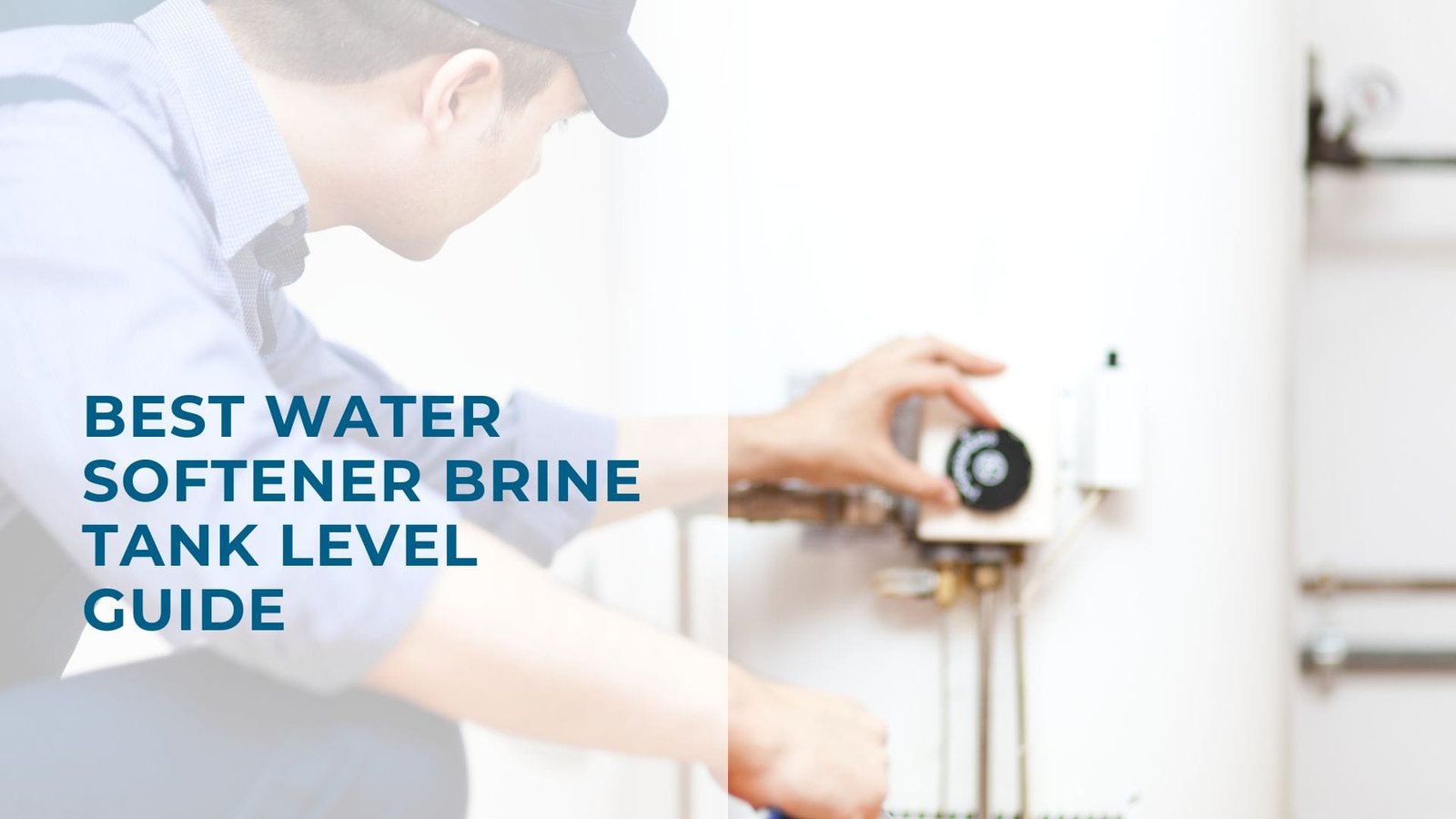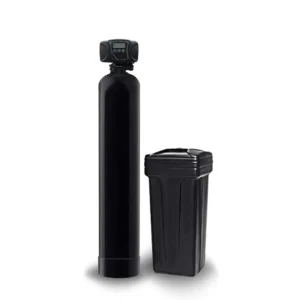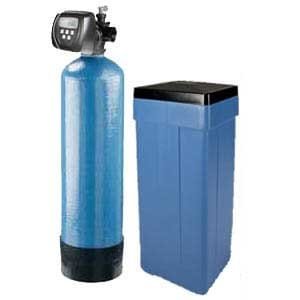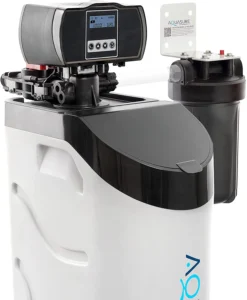Filteredwaterguide.com is supported by readers. If you purchase through referral links on our site, we make a commission at no extra cost to you. Learn more.

Hard water is one of the most frustrating household issues we encounter in our plumbing work.
We’ve seen countless homeowners invest in water softeners to combat those stubborn calcium and magnesium deposits that make cleaning such a challenge.
While these systems are remarkable at tackling limescale problems, our team has noticed that many homeowners struggle with proper maintenance.
One of the most common questions we get at Filtered Water Guide concerns the brine tank water level in salt-based water softeners.
Through our extensive testing and real-world experience, we’ve found that maintaining the correct water level is crucial for optimal performance.
In this comprehensive guide, we’ll share our expert knowledge about proper brine tank water levels and everything else you need to know about this essential component of your water softening system.
During our years of installing and maintaining water softeners, we’ve noticed that most salt-based systems come with two distinct tanks (though some models cleverly house both tanks within a single cabinet).
The main tank, equipped with a control head, is where the magic happens – it’s the heart of your water softener’s ion exchange process that eliminates calcium, magnesium, and other minerals responsible for those frustrating hard water-related issues throughout your home.
The second tank, known as the brine tank, plays an equally crucial role. Our team has found that this tank’s primary function is to create a concentrated salt solution that’s essential for the ion-exchange process to work effectively.

For a deeper understanding of the complete water softening process, we’ve put together a detailed article on how water softeners work.
In the image above, you can see a typical setup with the ion-exchange tank and control head positioned on the left, while the brine tank sits on the right.
Through our extensive testing of quality water softeners, we’ve confirmed that proper brine tank maintenance is absolutely essential for peak performance.
In our professional experience, water softener brine tanks come in two distinct varieties: wet brine tanks and dry brine tanks.
The key distinction lies in their water requirements – wet brine tanks maintain a constant water level, while dry brine tanks only need water added shortly before the ion exchange process begins.
Let’s explore exactly how much water your specific type of brine tank should contain.

In our decades of experience servicing water softeners, we’ve found that wet brine tanks are more common in traditional systems. While the exact water capacity varies by tank size, we can provide some reliable guidelines based on our field experience.
For compact wet brine tanks, we typically measure between 3 to 4 gallons of water, while larger models usually contain 5 to 6 gallons. However, these aren’t strict rules – we’ve encountered variations based on specific models and manufacturers.
While you can always consult your owner’s manual or contact the manufacturer directly, our team has developed a straightforward rule of thumb: the water level in a wet brine tank should always fall between 6 to 16 inches from the tank’s bottom. We’ve also observed that these systems typically consume more salt compared to dry brine tanks.

Despite their name, dry brine tanks aren’t completely waterless – our testing confirms they still require water to create the essential brine solution for mineral removal.
Not sure which type you have? Here’s a quick tip from our installation experience: check for a digital control valve or electrical connections on top of the tank. If you spot these components, you’re likely working with a dry brine system.
These digital valves serve a crucial purpose – they’re designed to precisely control water flow in and out of the softener system.
The water softener system shown above features a sophisticated two-tank design with a water-efficient dry-style brine tank, all fully encapsulated with smart controls.
(Note the smaller container to the right is a separate water treatment filter).
When working with dry brine tanks, determining proper water levels requires specific knowledge.
Through our extensive testing and field experience, we’ve found that these tanks should contain water only during a brief window – specifically one to two hours around regeneration time.
If you spot water in your dry brine tank outside of this regeneration window, we’ve got some concerning news: your salt-based water softening system needs attention.
Based on our hands-on experience with different brine tank configurations, here’s what you need to know about standing water:
Our testing confirms that dry brine tanks should remain exactly that – dry – except when regeneration is imminent.
The regeneration cycle serves a crucial purpose: it cleans the resin beads responsible for the hard water mineral removal ion exchange process.
During regeneration, we’ve observed that the system flushes all water from the main tank.
This process requires new sodium chloride or potassium chloride salt pellets to create the essential brine mixture for proper resin tank function.
This explains why water only enters a dry-style brine tank just before regeneration begins.
While standing water is normal in wet-style brine tanks (it’s right there in the name), we’ve learned through years of maintenance work that water levels still need careful monitoring.
In our professional assessment, water levels at or below half-full generally signal proper operation.
However, when we see levels climbing higher, we strongly recommend consulting a plumber or water softener specialist.
This recommendation becomes especially urgent if your water softener salt tank shows signs of extreme overfilling.
Through our diagnostic work, we’ve identified several potential causes for this issue:
After inspecting hundreds of water softening systems, we’ve identified several crucial factors that determine the proper water level in your brine tank.
Through our extensive field experience, we’ve discovered these key aspects that influence your brine tank’s water level:
During our installations, we’ve observed that the type of brine tank system significantly affects the standard water level.
Our testing reveals that system efficiency plays a vital role in water level management.
We’ve found that high-efficiency models maintain optimal performance with lower salt levels, naturally requiring less water in the tank.
In our professional assessments, we consistently verify that a 26% salt solution provides optimal performance for most systems.
Based on our testing, variations in this concentration or insufficient salt can lead to irregular water levels.
When we encounter brine tanks that are more than half full, it usually signals an underlying issue.
Our first recommendation is always to empty and thoroughly clean the tank, then replenish it with fresh salt to see if this resolves the problem.
If the water level quickly rises above the halfway mark again, we strongly recommend calling a professional technician for a thorough inspection.
Through years of servicing water softeners, we’ve seen firsthand how hard water can affect home plumbing systems.
A well-maintained water softener effectively prevents limescale buildup from calcium and other minerals that cause hard water problems.
The key to maintaining peak performance lies in proper brine tank maintenance, as we’ve outlined above.
We recommend following these guidelines along with your manufacturer’s specific maintenance instructions.
For homeowners who prefer hands-off maintenance, we suggest scheduling regular professional inspections.
This small investment helps ensure your water softener continues operating at maximum efficiency.